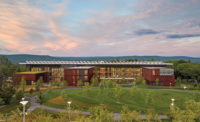Boston Squeezed as Colleges and Universities Expand
Columbia University, New York University, and other schools are planting ever larger footprints throughout Manhattan. But the Big Apple has plenty of company in managing tensions between academic institutions and their urban neighbors. Boston, the quintessential college town, is in for major changes as its schools accelerate their building programs. Although local officials generally welcome such projects, some plans are testing town-gown relationships.

The expansion of Harvard University’s campus in Allston, on the Boston side of the Charles River, commences in earnest this spring with groundbreaking on a 1-million-square-foot, $1 billion science center designed by Behnisch Architekten. The four-building complex of mid-rise Modernist structures is the first project in the school’s significant Allston build-up, which will likely include the relocation of Harvard’s schools of public health and education, as well as the construction of new student housing, museums, and performance space under a master plan created by Cooper Robertson & Partners, Frank Gehry, and the Olin Partnership.
“Harvard is clearly in a league of its own,” says Gerald Autler, senior project manager at the Boston Redevelopment Authority, the city’s planning agency. “They’ve got hundreds of acres and plans for 4 million - 5 million square feet of development over the next 10 to 20 years, and 10 million to 12 million square feet over the next 50 years.”
Ongoing negotiations between the university neighborhood groups over community benefits—including jobs, education programs, and infrastructure improvements—are proving contentious. Harvard offered to invest $21 million over 10 years but this amount falls significantly short of community demands, which include a community school serving all ages. Residents hope that the shortfall is not indicative of how negotiations will proceed during the coming decades of development.
“The process has been dysfunctional,” says Tim McHale, a member of the Allston Brighton Community Planning Initiative. “We want the building to happen, but Harvard hasn’t been open to community input.” University officials counter that they’ve taken residents’ priorities into account. The Allston campus plan is expected to be finished this fall, pending city approval.
Just southwest of Allston, Boston College straddles the Brighton neighborhood and the town of Newton. Its recent acquisition from the Roman Catholic Archdiocese of Boston of a roughly 70-acre property adjacent to the main campus opens the way for the construction of new dorms, a fine arts complex, and athletic facilities including a baseball stadium. A master plan by Sasaki Associates, which would expand the campus in the school’s collegiate Gothic style, is working its way through the public review process.
Brighton residents are raising concerns about round-the-clock activity, noise, stadium lights, and the loss of open space that could result from the expansion. For its part, Boston College seeks to retain much of the neighborhood’s open space and existing early-20th century buildings; it will also restrict the height of new construction to four or five stories, according to a spokesperson.
By contrast, Boston University, whose John Hancock Student Village is rising over Commonwealth Avenue along the Charles River west of downtown, has gone dramatically vertical to accommodate its own student housing needs, adding several thousands beds in two complexes of high-rises that range from to 15 to 26 stories tall. The mini-district, which includes athletic facilities, was designed by Cannon Design in a post-modern collegiate brick style. Its fourth and fifth towers are nearing completion.




